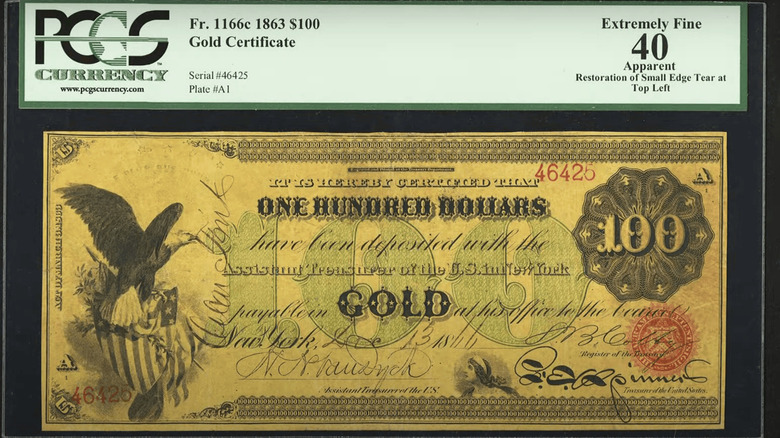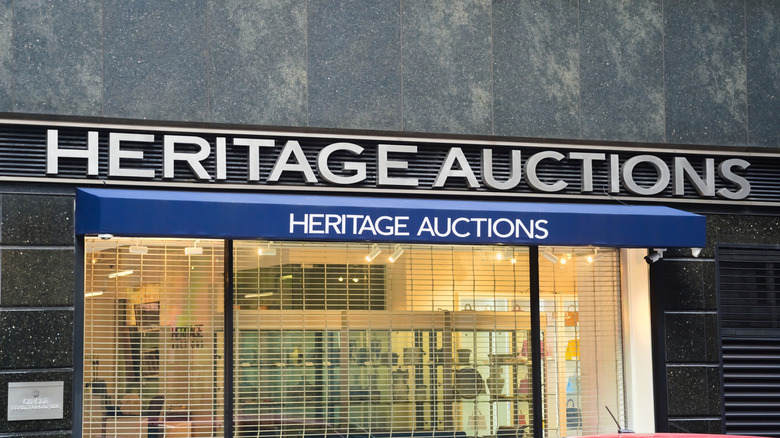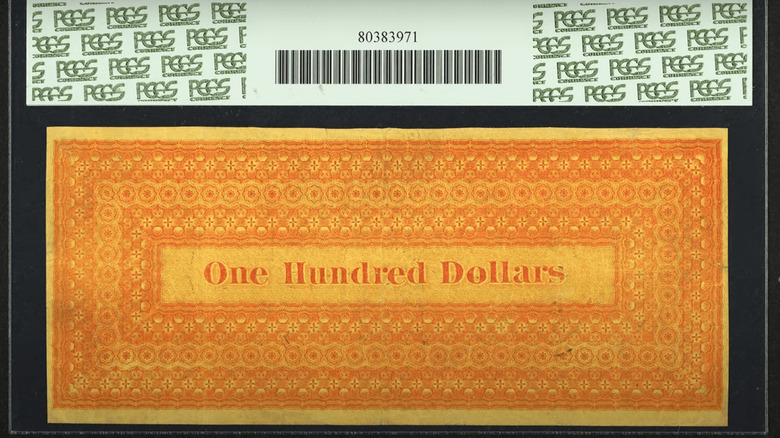Three Of These Bills Exist And One Could Fetch Up To $2 Million
Back in 1863, the U.S. government planned to print $100 gold certificates, but these didn't roll off the presses until 1865. Rumor has it, only three are still around today, making them super rare. The Bureau of Engraving and Printing confirms that these were part of a bigger batch of gold certificates started in 1863. They were like magic money back then because each note represented an exact amount of gold tucked away in the U.S. Treasury. So, instead of lugging around heavy gold, people could just carry these lightweight notes. Banks loved it; they could move big money easily without the hassle. But the $100,000 bill was basically monopoly money, used only by the Federal Reserve Banks for accounting, not everyday spending.
The 1863 $100 gold certificate was one of the tiniest big deals from the first batch of gold certificates, just a bit bigger than the $20 note. Per Heritage Auctions in Dallas, these two might have circulated together, though the $100 note was probably a rare sight. By 1933, these certificates became relics when the U.S. ditched the gold standard and yanked all gold certificates out of circulation. Then, the Gold Reserve Act in January 1934 put the final nail in the coffin, making it illegal for folks to own them. These certificates came in all sizes, but the 1863 $100 note had a majestic "Spread Eagle" perched on a shield, sporting the motto "E Pluribus Unum," which translates to "Out of many, one" in English.
The market for collectible currency
The 1863 $100 Gold Certificate is a true gem from America's past, minted right during the Civil War to pin the dollar to gold. This bill captures a moment when keeping the economy steady was top priority. What makes it even more coveted among collectors is its rarity — only one of these treasures is known to be in private hands today, making it a super rare find with collectors.
Condition is king when it comes to the value of a banknote. Collectors use grading systems to check out a bill's health, looking for creases, tears, and any signs of fading. The cleaner and crisper the bill, the more it's worth because it keeps its historical look intact. Collectors will shell out extra cash for those in top-notch condition, which is why keeping these bills in great shape is crucial for maintaining their value. Condition is also a massive driver for rare coins.
Same as demand. Collectors get really excited about owning pieces from specific eras, with certain designs or themes, and this excitement can push auction prices through the roof. For instance, back in 2013, a privately owned 1863 $100 Gold Certificate fetched over $2 million at a Heritage auction. This sale shows just how much collectors are willing to pay for unique, once-in-a-lifetime finds they see as priceless.
Turning the $100 Gold Certificate into cash
The first move in turning any collectible into cash is to verify it's legit. This is where pros like Paper Money Guaranty (PMG) or Professional Coin Grading Service (PCGS) come in. These professionals scrutinize everything — the material, printing techniques, watermarks, and other security features — to make sure the bill isn't a fake. Once it passes the test, they give it a grade that shows just how pristine or worn it is.
Condition grading is super important when figuring out a collectible's value. The grading scale goes all the way from "Poor" to "Gem Uncirculated." Even tiny differences, like a few minor creases or if the note still has that fresh-off-the-press crispness, can make a big splash in its market price. Getting a professional to grade your item does more than just put a number on its condition, it also adds a layer of trust and credibility, whether you're looking to sell it or insure it.
Keep up with market trends by checking out auction results and price guides to get the scoop on what collectors are paying for similar goodies. You can use sites like Heritage Auctions to get past auction data and price estimates. This info is your secret weapon to understanding how much demand there is for specific banknotes and what they're worth right now in the market.


